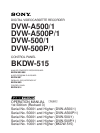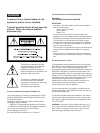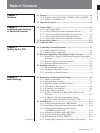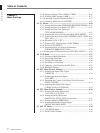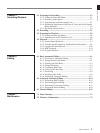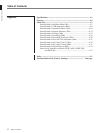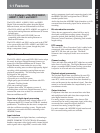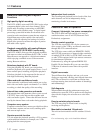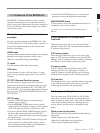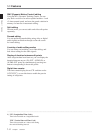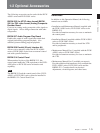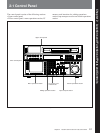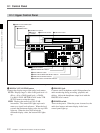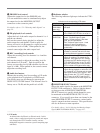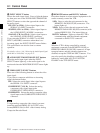
Chapter 1 Overview
Chapter 1 Overview 1-1
Chapter 1 Overview
1-1-1 Features of the DVW-A500/1,
A500P/1, 500/1 and 500P/1
The DVW-A500/1, A500P/1, 500/1, and 500P/1
Digital Videocassette Recorders adopt the Digital
Betacam format, and are differentiated as follows:
• The DVW-A500/1 and DVW-A500P/1 are capable of
playing back analog Betacam and Betacam SP format
cassette tapes.
• The DVW-500/1 and DVW-500P/1 are not
compatible with either the analog Betacam or
Betacam SP formats.
The DVW-A500/1 and 500/1 can be used in the NTSC
color system while the DVW-A500P/1 and 500P/1 can
be used in the PAL color system, though they both
adopt a component format.
Digital Betacam Format
The DVW-A500/1 series and DVW-500/1 series adopt
the newly developed Digital Betacam format as an
extension of the Betacam/Betacam SP format. The
Digital Betacam format makes the most of the
available recording area to achieve high-quality digital
recording, while maintaining analog Betacam tape
playback compatibility. The following have been
developed for this purpose:
•Coefficient recording system
• Powerful error correction system
•High-quality precision heads and drum with DT
®
(Dynamic Tracking) heads
•New auto tracking system
Together, these allow 120 minutes or more of
recording time on half-inch Digital Betacam (L-size)
cassettes the same size as those for conventional
Betacam and Betacam SP.
Overview of digial signal processing
Digital video signal processing is based on the 4:2:2
component digital D-1 format and CCIR 601 standard
quantization. In addition, the data rate is compressed
with the coefficient recording system. Digital audio
signals are processed in full bits conforming to the
AES/EBU format.
Input interface
The component serial digital interface, conforming to
SMPTE 259M/EBU T.3267/CCIR 656-III standards,
handles component video signals and 4-channel digital
audio signals with a single BNC coaxial cable. Both
analog component signals and composite signals (with
the BKDW-505/506) are digitized into CCIR 601
standard parallel data.
Audio data from the AES/EBU digital interface or A/D
converted data from analog input can be selected for
recording.
Bit rate reduction encoder
Video data are suppressed to about half by a newly
developed coefficient recording system, whose key
processes include field shuffling, blocking, DCT
(Discrete Cosine Transform), quantizing, and variable
length coding.
ECC encoder
The outer ECC (Error Correction Code) is added to the
compressed video and audio data, followed by the
inner ECC, ID data, and sync data. The Reed-
Solomon code is employed in this error correction
system.
Channel coding
Video and audio data with the ECC added are recorded
in the form of serial data. The Digital Betacam format
adopts a scrambled NRZI channel coding system that
is superior in off-track and noise characteristics.
Playback signal processing
The playback digital data are equalized by auto EQ
circuits and error-corrected by powerful inner and
outer ECC, which can correct most data disturbed by
noise and dropouts in the reproduced signal. Data that
cannot be corrected further are compensated by error
concealment circuits.
Output interface
Component video data are converted into serial data
and multiplexed with audio data, then output in the
serial digital interface format.
For analog output, component video data are D/A
converted into an analog component signal, while they
are encoded into composite digital, then D/A
converted into analog composite signal.
For audio outputs, the AES/EBU digital interface and
D/A converted analog audio are available.
1-1 Features



